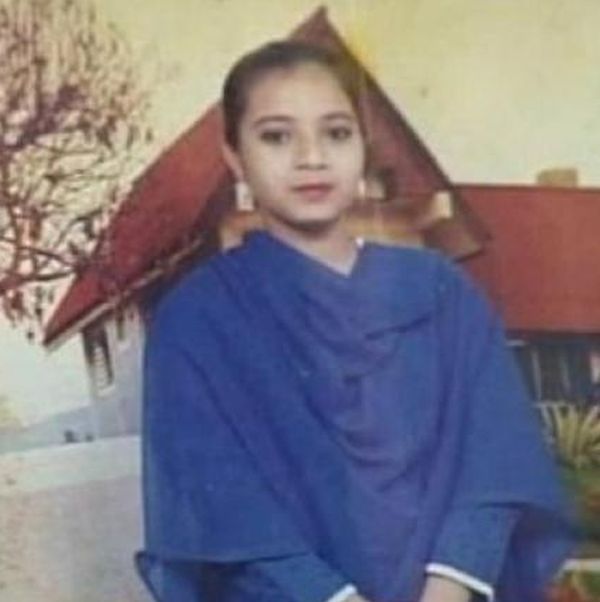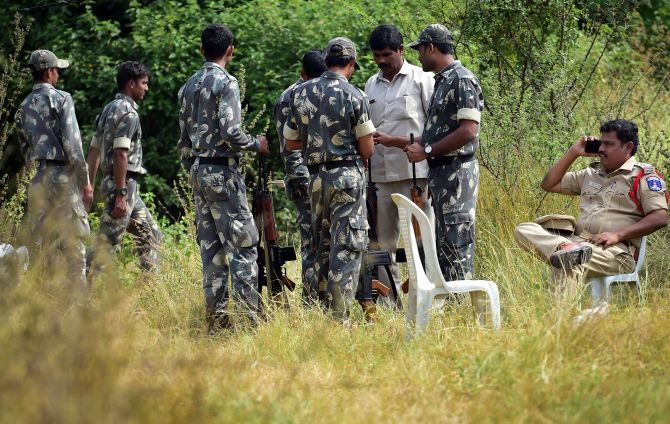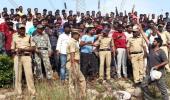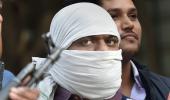Four accused in the Hyderabad rape-murder case were shot dead by the police on Friday morning.
This is not the first time India has witnessed a controversial police encounter.
Syed Firdaus Ashraf/Rediff.com lists some other encounters that stunned India.
SIMI terrorists killed in Bhopal (2016)

In 2016, eight SIMI activists were shot dead on the outskirts of Bhopal, hours after the undertrials allegedly slit a guard's throat and escaped from a city prison.
However, the operation kicked up a controversy after video footage emerged that purportedly showed a policeman pumping bullets into a man from close range. Some unidentified men were also seen in the video brandishing a knife that was neatly wrapped in a plastic cover.
Two years later, in 2018, a judicial commission appointed to probe the encounter termed the police action justified. The commission, headed by retired Madhya Pradesh high court judge S K Pandey, also gave the police a clean chit.
Sandalwood smugglers encounter (2015)

On April 7, 2015, 20 red sander smugglers were killed by the police in Andhra Pradesh's Chittoor district.
This was the highest death toll in a single encounter with the police in the history of red sanders smuggling.
Red Sanders Anti-Smuggling Task Force DIG Kantha Rao claimed the 'smugglers' attacked the team with sickles, rods and axes.
Asked if the attack could have been quelled without the use of deadly force, Rao claimed, 'We gave them several warnings, but they did not stop attacking us. There were over a hundred of them.'
Human rights groups did not believe the police version of the shootings. They alleged that the 'smugglers' were surrounded and murdered in cold blood.
Warangal encounter (2008)

In December 2008, the Andhra Pradesh police gunned down three men accused of throwing acid on two women engineering students.
The students -- Swapnika and Pranitha -- of the Kakatiya Institute of Technology in Warangal town were attacked after Swapnika had rejected the proposal of Srinivas, one of the accused.
Srinivas Rao, 25, the main accused in the case, and his associates P Harikrishna, 24, and B Sanjay, 22, were killed in the encounter.
While the police claimed they shot the men in self-defence, it is widely believed that the encounter was staged to quell the public outrage triggered by the crime.
Incidentally, V C Sajjanar, Hyderabad's current police commissioner, was Warangal's superintendent of police during that 2008 encounter.
Batla House (2008)

Eleven years ago, in 2008, in the Batla House encounter, two alleged Indian Mujahideen terrorists were killed and a decorated Delhi police officer lost his life.
According to the police, Indian Mujahideen terrorists were holed up in a house in the Batla House area in Delhi.
Police officer Mohan C Sharma died in the resultant encounter while two suspected terrorists, Atif Amin and Mohammed Sajid, were killed. Mohammad Saif, another suspected Indian Mujhaideen terrorist, was arrested whereas other two accused, Shahzad and Junaid, escaped.
Many alleged that the police had killed two innocent students in the Batla House encounter.
In 2010, Shahzad was arrested from Azamgarh and sentenced to life imprisonment in 2013.
A film was released this year on the encounter, starring John Abraham.
Ramnarayan Gupta case (2006)

In 2013, a Mumbai court awarded life sentences to 21 people, including 13 police personnel, for killing Ramnarayan Gupta alias Lakhan Bhaiya in a fake encounter in 2006.
Lakhan Bhaiya was considered to be gangster Chhota Rajan's close aide. Four days after his killing, his brother moved the Bombay high court, alleging that Bhaiya was killed in cold blood by the Mumbai police.
The inquiry established that the bullet that killed Lakhan Bhaiya was fired from point-blank range.
Investigations into the case revealed that Bhaiya was picked up by then Mumbai police encounter specialist Pradeep Sharma's (above) team from Navi Mumbai and later killed the same evening in an alleged encounter in Versova, north west Mumbai.
Sohrabuddin Sheikh (2005)

Sohrabuddin Sheikh was killed by the Gujarat police on November 26, 2005.
According to the police, Sheikh was associated with the Lashkar-e-Tayiba and the Pakistani intelligence agency Inter-Services Intelligence.
After Sheikh's killing his wife Kausar Bi was also shot dead by the Gujarat police in a similar manner.
An inquiry was ordered by the court into Sheikh's killing after which 22 people were arrested and that included then Gujarat minister of state for home, a certain Amit Anilchandra Shah.
Like the Ishrat Jahan case, this trial too went on for years. Finally, in 2018, a special CBI court acquitted all 22 accused.
Ishrat Jahan (2004)

Was the 19-year-old woman from Mumbra, a township near Mumbai, really a terrorist out to assassinate then Gujarat chief minister Narendra Damodardas Modi?
On June 15, 2004, Jahan along with three men were killed by the Gujarat police as they believed that the four of them had plotted to to kill Modi.
Following the outrage, the Supreme Court ordered the Central Bureau of Investigation to investigate the killings, which filed a chargesheet against several Gujarat police officers for their involvement in the crime.
After 17 years, in May 2019, D G Vanzara, who led the encounter and was subsequently jailed, was discharged from the case.
The trial is still underway in the Ahmedabad special CBI court where Ishrat's mother Shamim Kausar recently filed an application seeking her withdrawal from the case as she 'was tired of fighting it for so many years'.











